A) -$3
B) $3
C) $9
D) $24
F) A) and C)
Correct Answer

verified
Correct Answer
verified
Multiple Choice
Figure 15-21  -Refer to Figure 15-21. What is the price and quantity for this natural monopolist under socially optimal pricing?
-Refer to Figure 15-21. What is the price and quantity for this natural monopolist under socially optimal pricing?
A) A and J
B) E and J
C) F and K
D) H and L
F) C) and D)
Correct Answer

verified
Correct Answer
verified
Multiple Choice
Table 15-9
Consider the following demand and cost information for a monopoly.  -Refer to Table 15-9. What is the marginal revenue of the 3rd unit?
-Refer to Table 15-9. What is the marginal revenue of the 3rd unit?
A) $4
B) $12
C) $20
D) $28
F) A) and C)
Correct Answer

verified
Correct Answer
verified
Multiple Choice
Figure 15-1 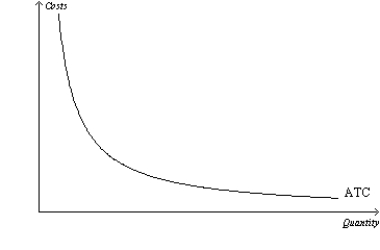 -Refer to Figure 15-1. The shape of the average total cost curve reveals information about the nature of the barrier to entry that might exist in a monopoly market. Which of the following monopoly types best coincides with the figure?
-Refer to Figure 15-1. The shape of the average total cost curve reveals information about the nature of the barrier to entry that might exist in a monopoly market. Which of the following monopoly types best coincides with the figure?
A) ownership of a key resource by a single firm
B) natural monopoly
C) government-created monopoly
D) a patent or copyright monopoly
F) B) and C)
Correct Answer

verified
Correct Answer
verified
Multiple Choice
Figure 15-18 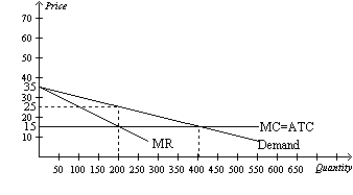 -Refer to Figure 15-18. If the monopoly firm perfectly price discriminates, then the deadweight loss amounts to
-Refer to Figure 15-18. If the monopoly firm perfectly price discriminates, then the deadweight loss amounts to
A) $0.
B) $1,000.
C) $2,000.
D) $4,000.
F) All of the above
Correct Answer

verified
Correct Answer
verified
Multiple Choice
Scenario 15-5 An airline knows that there are two types of travelers: business travelers and vacationers. For a particular flight, there are 100 business travelers who will pay $600 for a ticket while there are 50 vacationers who will pay $300 for a ticket. There are 150 seats available on the plane. Suppose the cost to the airline of providing the flight is $20,000, which includes the cost of the pilots, flight attendants, fuel, etc. -Refer to Scenario 15-5. How much additional profit can the airline earn by charging each customer their willingness to pay relative to charging a flat price of $600 per ticket?
A) $15,000
B) $25,000
C) $40,000
D) $70,000
F) C) and D)
Correct Answer

verified
Correct Answer
verified
Multiple Choice
Table 15-7
Sally owns the only shoe store in town. She has the following cost and revenue information. 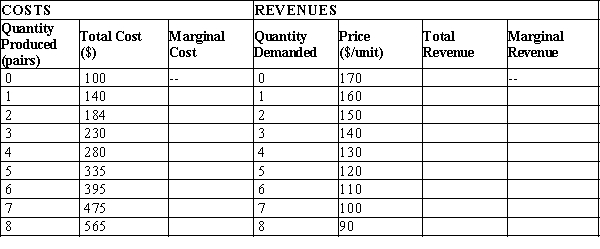 -Refer to Table 15-7. What are Sally's fixed costs?
-Refer to Table 15-7. What are Sally's fixed costs?
A) $0
B) $100
C) $600
D) $745
F) B) and C)
Correct Answer

verified
Correct Answer
verified
Multiple Choice
Scenario 15-10
Vincent operates a scenic tour business in Boston. He has one bus which can fit 50 people per tour and each tour lasts 2 hours. His total cost of operating one tour is fixed at $450. Vincent's cost is not reduced if he runs a tour with a partially full bus. While his cost is the same for all tours, Vincent charges each passenger his/her willingness to pay: adults $18 per trip, children $10 per trip, and senior citizens $12 per trip. At those rates, on a typical day Vincent's demand is:  Assume that Vincent's customers are always available for the tour; therefore, he can fill his bus for each tour as long as there is sufficient total demand for the day.
-Refer to Scenario 15-10. What is Vincent's total revenue on a typical day?
Assume that Vincent's customers are always available for the tour; therefore, he can fill his bus for each tour as long as there is sufficient total demand for the day.
-Refer to Scenario 15-10. What is Vincent's total revenue on a typical day?
A) $1,500
B) $1,800
C) $2,170
D) $2,700
F) B) and D)
Correct Answer

verified
Correct Answer
verified
Multiple Choice
Scenario 15-5 An airline knows that there are two types of travelers: business travelers and vacationers. For a particular flight, there are 100 business travelers who will pay $600 for a ticket while there are 50 vacationers who will pay $300 for a ticket. There are 150 seats available on the plane. Suppose the cost to the airline of providing the flight is $20,000, which includes the cost of the pilots, flight attendants, fuel, etc. -Refer to Scenario 15-5. How much profit will the airline earn if it sets the price of each ticket at $300?
A) -$15,000
B) -$5,000
C) $25,000
D) $45,000
F) A) and B)
Correct Answer

verified
Correct Answer
verified
Multiple Choice
Table 15-11
The following table shows quantity, price, and marginal cost information for a monopoly:  -Refer to Table 15-11. What price should the firm charge to maximize its profit?
-Refer to Table 15-11. What price should the firm charge to maximize its profit?
A) $4
B) $5
C) $6
D) $7
F) All of the above
Correct Answer

verified
Correct Answer
verified
Multiple Choice
Figure 15-4 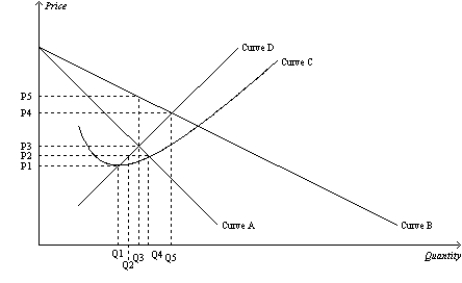 -Refer to Figure 15-4. The marginal revenue curve for a monopoly firm is depicted by curve
-Refer to Figure 15-4. The marginal revenue curve for a monopoly firm is depicted by curve
A) A.
B) B.
C) C.
D) D.
F) B) and C)
Correct Answer

verified
Correct Answer
verified
Multiple Choice
Figure 15-11 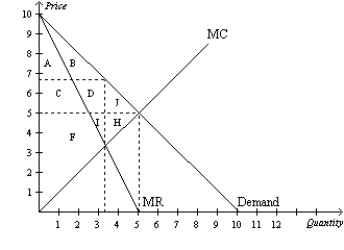 -Refer to Figure 15-11. Which area represents the deadweight loss from monopoly?
-Refer to Figure 15-11. Which area represents the deadweight loss from monopoly?
A) J
B) H
C) A+B+C+D+F+I+J+H
D) J+H
F) All of the above
Correct Answer

verified
Correct Answer
verified
Multiple Choice
The deadweight loss associated with a monopoly occurs because the monopolist
A) maximizes profits.
B) produces an output level less than the socially optimal level.
C) produces an output level greater than the socially optimal level.
D) equates marginal revenue with marginal cost.
F) B) and C)
Correct Answer

verified
Correct Answer
verified
Multiple Choice
Table 15-3
Consider the following demand and cost information for a monopoly.  -Refer to Table 15-3. The maximum profit this monopolist can earn is
-Refer to Table 15-3. The maximum profit this monopolist can earn is
A) $5.
B) $15.
C) $16.
D) $28.
F) None of the above
Correct Answer

verified
Correct Answer
verified
Multiple Choice
Scenario 15-5 An airline knows that there are two types of travelers: business travelers and vacationers. For a particular flight, there are 100 business travelers who will pay $600 for a ticket while there are 50 vacationers who will pay $300 for a ticket. There are 150 seats available on the plane. Suppose the cost to the airline of providing the flight is $20,000, which includes the cost of the pilots, flight attendants, fuel, etc. -Refer to Scenario 15-5. How much profit will the airline earn if it engages in price discrimination?
A) -$5,000
B) $40,000
C) $55,000
D) $75,000
F) C) and D)
Correct Answer

verified
Correct Answer
verified
Short Answer
Figure 15-1  -Refer to Figure 15-1. If the monopolist uses perfect price discrimination, how much profit does the firm earn?
-Refer to Figure 15-1. If the monopolist uses perfect price discrimination, how much profit does the firm earn?
Correct Answer

verified
Correct Answer
verified
Multiple Choice
Table 15-18
A monopolist faces the following demand curve:  Suppose marginal cost is constant at $8 per unit.
-Refer to Table 15-18. The monopolist's marginal revenue is
Suppose marginal cost is constant at $8 per unit.
-Refer to Table 15-18. The monopolist's marginal revenue is
A) always more than the price of its good, beyond the first unit.
B) always equal to the price of its good.
C) always less than the price of its good, beyond the first unit.
D) sometimes more and sometimes less than the price of its good.
F) A) and C)
Correct Answer

verified
Correct Answer
verified
Multiple Choice
Table 15-15
A monopolist faces the following demand curve:  -Refer to Table 15-15. The monopolist has total fixed costs of $40 and a constant marginal cost of $5. At the profit-maximizing level of output, the monopolist's profit is
-Refer to Table 15-15. The monopolist has total fixed costs of $40 and a constant marginal cost of $5. At the profit-maximizing level of output, the monopolist's profit is
A) $88.
B) $8.
C) $6.
D) We do not have enough information to determine profit.
F) None of the above
Correct Answer

verified
Correct Answer
verified
Multiple Choice
Scenario 15-1 Consider a transportation corporation named Reading's that has just completed the development of a new light rail system in Minneapolis. Currently, there are plenty of seats on the train, and it is never crowded. Its capacity far exceeds the needs of the city. After just a few years of operation, the shareholders of Reading's experienced incredibly high rates of return on their investment due to the profitability of the corporation. -Refer to Scenario 15-1. Which of the following statements is most likely to be true? (i) New entrants to the market know they will have a smaller market share than Reading's currently has. (ii) Reading's is a natural monopoly. (iii) Reading's is most likely experiencing increasing average total cost.
A) (i) and (ii) only
B) (ii) and (iii) only
C) (i) and (iii) only
D) (i) , (ii) , and (iii)
F) All of the above
Correct Answer

verified
Correct Answer
verified
True/False
A monopolist is able to choose whatever price that it wishes and is only constrained by its greed.
B) False
Correct Answer

verified
Correct Answer
verified
Showing 241 - 260 of 662
Related Exams